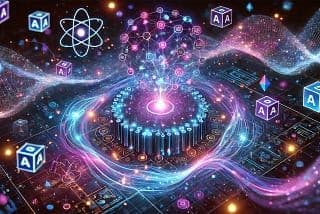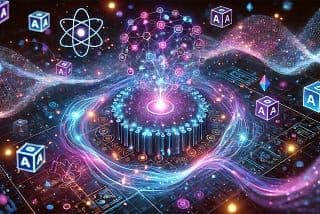Introduction
Quantum mechanics revolutionized physics by introducing the idea that everything, at a fundamental level, is composed of discrete particles. This framework, which defines reality in terms of quantized entities such as photons and electrons, has reshaped our understanding of nature. In a strikingly similar manner, Large Language Models (LLMs) are revolutionizing artificial intelligence by demonstrating that everything — language, vision, acoustic information, and even abstract reasoning — can be tokenized. Just as quantum theory provides a universal framework for describing the microscopic world, LLMs provide a universal framework for encoding and interpreting diverse modalities of information through tokens.

The Fundamental Assumption: Quantization vs. Tokenization
At the core of quantum mechanics is the principle that energy and matter exist in discrete packets called quanta. In AI, particularly in LLMs, the equivalent concept is tokenization, where all forms of data — whether textual, visual, or auditory — are broken down into fundamental discrete units called tokens. This transformation allows AI models to process and understand various forms of information under a unified framework, much like quantum mechanics allows for a standardized interpretation of physical interactions at microscopic scales.
Language as Tokens
LLMs were initially designed for natural language processing, where words, subwords, and characters are converted into tokens. These tokens serve as the building blocks for training the model to predict and generate text, analogous to how particles interact in quantum fields to generate observable phenomena.
Vision as Tokens
Recent advancements, such as Vision Transformers (ViTs), have extended the concept of tokenization to the visual domain. Images are divided into small patches, which are then treated as tokens, enabling LLM-like architectures to process visual information effectively. This approach mirrors the way quantum theory describes visual perception through quantized light interactions.
Acoustic Information as Tokens
Similarly, speech and acoustic data can be tokenized into phonemes or other subword-like audio representations. This allows LLM-based architectures to process and generate human-like speech by treating sound as a sequence of discrete elements, akin to how quantum mechanics treats sound waves in terms of phonons.
Parallel Principles: Superposition, Entanglement, and Predictive Modeling
Beyond the fundamental unitization of information, deeper parallels exist between quantum mechanics and LLMs in their functional principles.
Superposition and Probabilistic Nature
In quantum mechanics, particles exist in superposition, meaning they can occupy multiple states simultaneously until measured. Similarly, LLMs generate responses probabilistically, considering multiple possibilities for the next token at each step before collapsing into a final output. Just as a quantum wavefunction collapses upon observation, an LLM collapses its probability distribution into a single token upon generation.
Entanglement and Contextual Understanding
Quantum entanglement describes how particles become interdependent, such that the state of one instantly influences another regardless of distance. In LLMs, token dependencies create a form of “semantic entanglement” where distant words or concepts influence each other. This interconnectedness allows models to maintain contextual coherence over long passages of text, much like entangled quantum states maintain correlations across space and time.
Predictive Models: Schrödinger’s Equation and Transformer Attention
Quantum physics relies on predictive equations such as Schrödinger’s equation to determine the evolution of particle states. Similarly, the attention mechanisms in Transformer-based models enable them to predict future tokens based on prior ones, dynamically adjusting probabilities as new information is introduced. The mathematical similarity between quantum wavefunctions and LLM probability distributions further reinforces the alignment between these two domains.
The Universal Framework for AI
The universality of quantum mechanics allows it to describe a vast array of physical phenomena. Likewise, LLMs have demonstrated the capacity to generalize across multiple domains, providing a unified approach to processing different data types. Just as quantum mechanics replaced classical physics for microscopic phenomena, tokenization-driven AI models are replacing traditional task-specific algorithms, setting a new standard for artificial intelligence.
Conclusion
Quantum mechanics and LLMs share a fundamental insight: reality can be discretized and modeled using mathematical formalisms based on fundamental units — quanta in physics and tokens in AI. This alignment suggests that LLMs are not merely specialized tools for language processing but rather a foundational framework for AI, capable of integrating and interpreting diverse forms of data. As research continues to push the boundaries of both quantum theory and AI, we may find that the principles governing particles and tokens are not just similar but deeply interconnected, potentially unlocking new paradigms of intelligence and computation.
